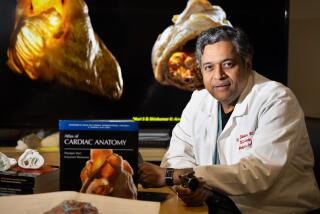BOOK REVIEW : A Savior of Nature’s Smallest Victims : THE WORK OF HUMAN HANDS: Surgical Wonder at Children’s Hospital by G. Wayne Miller Random House: $23.00, 384 pages
When I first picked up my review copy of “The Work of Human Hands,” the book fell open to Page 218. What I read there literally took my breath away:
*
We have ... plenty of colon. Seems to have a good blood supply, which will help if we have to make a vagina . . . . Have a functionless multicystic kidney to get rid of, but we’ll do that when we turn her over. We’ll have to take that ureter out as well....
The words are spoken by a surgeon named W. Hardy Hendren III as he describes the “anatomic anarchy” that he finds inside the tormented body of little Lucy Moore, a baby whose internal organs are ravaged by a cluster of birth defects known as “cloaca.” As he speaks, Hendren is working a medical miracle by surgically rearranging Lucy’s internal anatomy and creating for her the organs that nature neglected to give her.
Hendren is chief of pediatric surgery at Children’s Hospital in Boston. In a sense, “The Work of Human Hands” by G. Wayne Miller is a biography of Hendren, an insider’s account of the workings of Children’s Hospital and a history of the surgical treatment of catastrophic birth defects. But Miller’s book is really something more--a song of suffering and redemption that is harrowing to read and impossible to forget.
So devastating are the birth defects encountered by Hendren that the reader will be moved to horror and heartache. So remarkable are Hendren’s surgical successes at repairing broken babies that some colleagues have accused him of “falsifying his results by fiddling with his pre- and post-operative slides.” And yet Hendren is so meticulous that he insists on cleaning and bandaging surgical wounds of his patients, “an unglamorous chore many chief surgeons relegate to their assistants.”
Hendren comes across as a genius. He is not always likable, but his drive and dedication cannot be faulted: “Hendren took intractable problems personally,” writes Miller, “as if . . . the . . . deformities he took on had been put into existence with the specific purpose of taunting him.”
The condition that afflicted Lucy Moore is known as cloaca, a Greek term that means sewer and refers to “a congenital persistence of an early embryologic stage where everything empties into a single chamber.” To put it bluntly, a cloaca baby is born without vagina, anus or urethra.
Only one in 50,000 live births results in a cloaca baby. Lucy Moore was a victim of those odds, but she was fortunate enough to find her way into the skilled hands of Hendren. As we read in “The Work of Human Hands,” the ordeal that Lucy and her parents endured--and the surgical remedy--transcend the realm of medicine and turn into something rich and strange.
Miller, of course, is deeply impressed with Hendren, and intends the reader to be impressed. We are allowed to understand that the good doctor can be arrogant: “Hardly Human” is his nickname. But Miller also suggests that Hendren’s surgical genius is so rare that he cannot pass on his surgical techniques to others: “When he’s gone,” says one doctor, “a lot of kids are going to be screwed up.”
Miller, a journalist and novelist, is capable of clear and plain-spoken description of the most horrific anatomical defects and the most complex surgical procedures. But he is not afraid to express the shattering emotions that his book will inspire in the human heart: “The most profound lesson was that once having decided to be cruel,” Miller writes of cloaca, “Nature could demonstrate an almost satanic creativity.”
Miller shows us that medical science is capable of an almost divine creativity in dealing with birth defects. For a baby born with deformed or missing organs, the surgeon can fashion a new set out of cannibalized body parts: Stomach tissue is used to enlarge a bladder, the buttocks to fashion genitalia. And, indeed, the choices a doctor is called upon to make are truly godlike: Should a male infant with “ambiguous genitalia” be given a vagina and raised as a girl?
Only rarely does a work of nonfiction equal or surpass the novel in the art of story-telling, the play of emotion and the sheer grandeur of human spirit. “Alive!” by Piers Paul Reed was such a book. So was Bruce Chatwin’s “The Songlines” and, more recently, Norman Maclean’s “Young Men and Fire.” To this short list I must add “The Work of Human Hands.”
More to Read
Sign up for our Book Club newsletter
Get the latest news, events and more from the Los Angeles Times Book Club, and help us get L.A. reading and talking.
You may occasionally receive promotional content from the Los Angeles Times.







